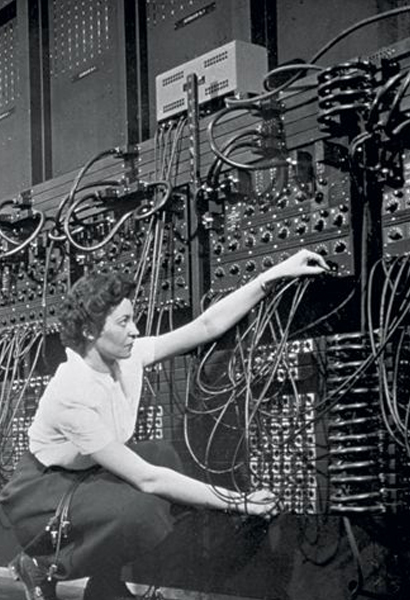

Birth: 1924
Death: 1986
Specialty: Mathematics, Computer Programming
Major Contributions:
Programmed the ENIAC
Women in Technology International Hall of Fame
Image Source: Wikimedia
When the ENIAC computer was first invented, there was no such thing as computer programming. The methods and protocols had to be invented, and a group of six women were the first to do that. This week we’ve been honoring those women, and today we’d like to introduce Ruth Lichterman Teitelbaum.
Born in 1924, Teitelbaum earned a bachelor’s degree in mathematics from Hunter College before being brought on as a “computer” at Moore School of Engineering. As part of a group of about eighty women, Teitelbaum manually calculated ballistic trajectories for the Army until she was selected to work on the ENIAC. She worked closely with Marlyn Meltzer, another programmer. The two performed a vital function for the February 1946 public demonstration: carrying out a manual calculation to prove the machine had worked properly. Their manual work helped debug the machine as the engineers and programmers prepared for the big event.
The women behind the ENIAC not only programmed the machine itself, but several also taught others their methods, passing the first work in the subject on to the next generation of computer programmers. Teitelbaum moved with the ENIAC to Aberdeen Proving Grounds in 1946 and worked there for two years, teaching programming and continuing her work. Teitelbaum was the last of the original six to remain employed at Aberdeen, retiring on September 10th, 1948 when she was married.
Teitelbaum passed away in 1986, and during her lifetime the women who worked on the ENIAC were not given credit for their contributions to computing. In 1997, they were inducted into the Women in Technology International Hall of Fame, and Teitelbaum’s husband was there to accept in her honor.
Since then, the ENIAC Programmer Project was founded by lawyer Kathy Kleiman. The project aims to fully record the contributions of the original six women, and write them back into computing history. Kleiman says that the women not only programmed the first computer, but “dedicated years after the war to making programming easier and more accessible for all of us who followed.”
Written by Mary Ratliff
Sources:
Engineering and Technology History Wiki: Ruth Teitelbaum
Finding the forgotten women who programmed the world’s first electronic computer (Science Friday)
ENIAC In Action: Making and Remaking the Modern Computer
BETTY HOLBERTON | PHILADELPHIA WOMEN’S HISTORY MONTH ALL-STAR
See Also:
The ENIAC Programmers (As told by U.S. Chief Technology Officer Megan Smith)
